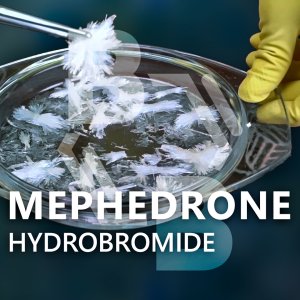You should upgrade or use an alternative browser.
Guide to 2-bromo-4'-methylpropiophenone Synthesis
Guide to 2-bromo-4'-methylpropiophenone Synthesis
The organic synthesis world has been enriched by the production of compounds like 2-bromo-4'-methylpropiophenone. This article covers the in-depth 2-bromo-4'-methylpropiophenone (cas 1451-82-7) synthesis. Bromination reaction is easily scaled under these conditions. Basic rule: hydrogen peroxide is added slowly in order to avoid the reaction mixture splashing. It is better to use a top stirrer because a magnetic stirrer doesn't cope with the sediment. Blades of stirrer must be covered with ftoroplast (Teflon) in order to avoid reactions with hydrobromic (HBr) acid.
Reagents:
- 4′-Methylpropiophenone (cas 5337-93-9) 1000 g;
- Hydrobromic acid 48% aq. 1300 g;
- Hydrogen peroxide (H2O2) 35% 750 g;
- Sodium bicarbonate (NaHCO3);
- Distilled water;
Equipment and Glassware:
- Three necked round bottom flask 5 L;
- Retort stand and clamp for securing apparatus;
- Reflux condenser;
- Funnel;
- Drip funnel 1 L;
- Top stirrer;
- Sieve filter (kitchen grade is ok);
- Water bath;
- Heating plate;
- Syringe or Pasteur pipette;
- pH indicator papers;
- Beakers (600 mL x2, 2 L, 1 L, 100 mL x2);
- Vacuum source;
- Laboratory scale (0.1-1000 g is suitable);
- Measuring cylinders 1000 mL and 100 mL;
- Glass rod and spatula;
- Laboratory grade thermometer;
- Buchner flask and funnel;
- Filter paper;
2-Bromo-4'-methylpropiophenone Synthesis
2. Hydrobromic (HBr) acid 1300 g 48% is poured into the flask and stirred for 5 min.
3. Hydrogen peroxide 750 g 35% is added into a drip funnel 1 l.
4. Hydrogen peroxide is added dropwise to the stirred reaction mixture.
5. Bromine is released during hydrogen peroxide addition to the mixture, dissolved in solution and reacted.
6. Hydrogen peroxide must be added at an appropriate rate so that the reaction mixture becomes colorless.
7. Reaction mixture temperature have to be kept less than 65 °C. An external cooling is applied in case of overheating. If reaction temperature is higher, hydrogen peroxide addition is stopped.
8. The second part of discoloration reaction can be conducted for longer time. Hydrogen peroxide is added according with reaction temperature.
9. Reaction mixture is left for a 12 h with a constant stirring at room temperature as soon as all hydrogen peroxide is added.
10. After 12 h precipitate is formed.
11. Sodium bicarbonate aq solution is added to the reaction mixture to reach neutral pH 6-7, stir it well. The mixture with 2-bromo-4'-methylpropiophenone is filtered through a Buchner funnel. Product is washed with small amount of distilled water.
12. Crude 2-bromo-4'-methylpropiophenone (cas 1451-82-7) is used for further reactions. Theoretical yield up to 1530 g. Practice yield is almost quantitative (video yield 94%).
Conclusion
The synthesis of 2-bromo-4'-methylpropiophenone and its derivatives offers immense potential for various applications. It's essential to approach the process with precision, an insight of each step's intricacies, and always prioritizing safety.
Bibliography
Gaspar, Helena, et al. "Proactive response to tackle the threat of emerging drugs: Synthesis and toxicity evaluation of new cathinones." Forensic science international 290 (2018): 146-156. https://www.sciencedirect.com/science/article/abs/pii/S0379073818303797
-

2-Bromo-4'-methylpropiophenone
Purity: 99% CAS: 1451-82-7 Formula: C10H11BrO Our company carries out the delivery of any goods that are not prohibited by law from China to the EU. You can receive your goods in a specially equipped cache or by courier delivery.- Cargo Chemicals
- Resource
- 2-bromo-4'-methylpropiophenone
- Category: Aldehydes and Ketones
-

2B4M/BK4 2-Bromo-4'-methylpropiophenone CAS 1451-82-7
Payment Terms: TT, Bitcoin, USDT, XMR, Western Union, MoneyGram, Escrow Delivery: 100% safe, fast, secure, and discreet with undetectable packaging and delivery worldwide Moscow of Russia spot stock, pick-up is supported, hot in Europe Price: 1Kg USD150 100Kg USD120/Kg (Moscow 275Kg spot...- Winni Win
- Resource
- 2-bromo-4'-methylpropiophenone 2b3m 2b4m bk4 cas 1451-82-7
- Category: Aldehydes and Ketones
-

Mephedrone hydrobromide synthesis
Mephedrone hydrobromide synthesis from 2-bromo-4'-methylpropiophenone with n-methylpyrrolidone https://bbgate.com/threads/synthesis-of-mephedrone-in-nmp-large-scale.231/- Novator
- Media item
- 2-bromo-4'-methylpropiophenone 4-mmc bromoketone cas 1451-82-7 meph mephedrone mephedrone hydrobromide mephedrone hydrochloride n-methylpyrrolidone nmp
- Comments: 26
- Category: Synthesis of Methcathinones
-

4′-Methylpropiophenone bromination to 2-bromo-4'-methylpropiophenone. Large scale.
Reaction scheme: Reagents: 4′-Methylpropiophenone (cas 5337-93-9) 1000 g; Hydrobromic acid 48% aq. 1300 g; Hydrogen peroxide (H2O2) 35% 750 g; Sodium bicarbonate (NaHCO3); Distilled water; Equipment and glassware: Three necked round bottom flask 5 L; Retort stand and clamp for securing...- WillD
- Thread
- 2-bromo-4'-methylpropiophenone 4-mmc 4-mmc synthesis 4′-methylpropiophenone 4′-methylpropiophenone bromination cas 1451-82-7 cas 5337-93-9 cathinone mephedrone mephedrone synthesis
- Replies: 45
- Forum: Methcathinones
-

2-Bromo-4'-methylpropiophenone synthesis from 4'-methylpropiophenone. Bromination in DCM or GAA.
Reaction scheme: Reagents: 4-methylpropiophenone (cas 5337-93-9) - 1000 g; Dichloromethane (DCM) or glacial acetic acid (GAA) - 3000 ml; Bromine (Br2) - 1080g, 348 ml; Sodium bicarbonae (NaHCO3) solution; Distilled water; Magnesium sulphate (MgSO4); Equipment and glassware: Three necked...- WillD
- Thread
- 2-bromo-4'-methylpropiophenone 4'-methylpropiophenone 4-mmc cas 1451-82-7 cas 5337-93-9 cathinone mephedrone
- Replies: 17
- Forum: Methcathinones
-

Mephedrone (4-MMC) synthesis from haloketone in ethyl acetate. 1-10 kg Scale.
Reaction scheme: Reagents: 1. 4'-Methylpropiophenone (cas 5337-93-9) 1 kg; 2. Hydrobromic acid 48% 1300 ml; 3. Hydrogen peroxide 35% 750 ml; 4. Sodium/potassium hydroxide 25% (NaOH/KOH) aqueous solution; 5. Distilled water; 6. Ethyl acetate 6 l; 7. Methylamine 40% aq - 2 l; 8. Acetone - 8 l...- WillD
- Thread
- 2-bromo-4'-methylpropiophenone 4'-methylpropiophenone 4-mmc ethyl acetate 4-mmc synthesis cas 1189726-22-4 cas 1451-82-7 cas 74-89-5 mephedrone ethyl acetate synthesis mephedrone synthesis methylamine
- Replies: 53
- Forum: Methcathinones
About Us
Our team brings together the best specialists from different fields.
We are ready to share our experience, discuss difficult issues and find new solutions.
Mirror Links
Help Pages
Follow us
Popular Tags
-
Free product samples
Testing products from new vendors and manufacturers.
Get free samples for testing now!
-
Always stay in touch with BB forum. Element/Matrix.
Connect notifications to always stay in touch with the forum!
Connect
